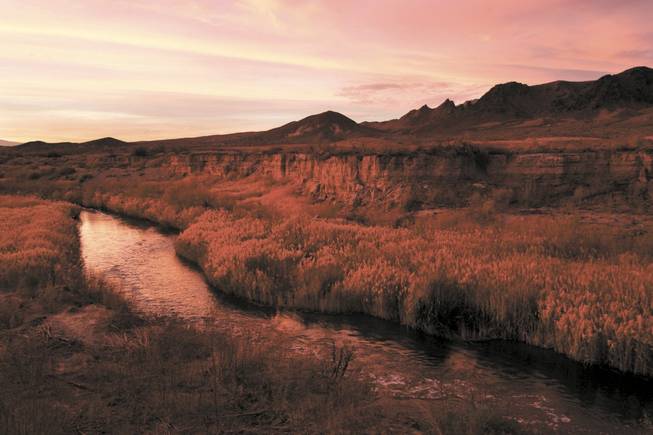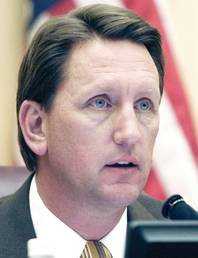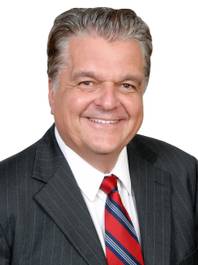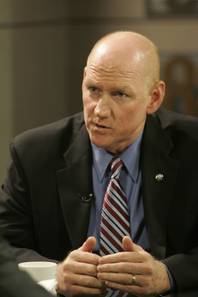
At one time, the Clean Water Coalition had planned a pipeline that would have crossed this stretch of the Las Vegas Wash to expel treated wastewater into the deeper depths of greater Lake Mead. However, the CWC mothballed that project and the Nevada Legislature took $62 million allocated for it.
Wednesday, March 9, 2011 | 2:01 a.m.

Steve Kirk

Steve Sisolak

Larry Brown
Sun Coverage
Sun archives
- Clean Water Coalition will sue state to keep $62 million targeted by lawmakers (3-11-2010)
- Clean Water Coalition balks at localities’ request to return cash (1-10-2010)
- Las Vegas to pull out of Clean Water Coalition (9-15-2010)
- State: Reno wrong to support Southern Nevada in $62M battle (5-27-10)
- Reno sides with Southern Nevada in Legislature battle (5-24-10)
- Governor, Legislature seek to keep $62 million for state budget (3-18-10)
- Gibbons signs budget bill; state draws M Resort lawsuit (3-12-10)
- Clean Water Coalition will sue state to keep $62 million targeted by lawmakers (3-11-10)
- Will a gamer sue the state over part of special session budget plan? (3-2-10)
Millions of dollars are being collected in Southern Nevada for a small public agency that no longer exists.
And although Clark County plans to return about $2.7 million to sewer ratepayers, other municipalities have yet to decide whether to keep the money they have collected on behalf of the Clean Water Coalition, earmark it for another purpose or return it to people who paid it.
The coalition was established in 2002 to oversee construction of an $860 million pipeline to return treated, phosphorous-rich wastewater deep into Lake Mead so it would not promote shoreline algae blooms that threaten water quality. But almost 10 years later, water treatment experts say the pipeline is no longer needed because of new wastewater treatment technology.
The Clean Water Coalition is scheduled to be formally shuttered in June. Its board decided it would not collect fees for the pipeline after Oct. 1.
But fees are still being collected.
Henderson collects a monthly fee for the Clean Water Coalition from utility ratepayers, about $8 annually. For the moment, it doesn’t have plans to refund the money or stop collecting it.
The city is considering a new use for the fee, which brings in about $800,000 annually, said City Councilman Steve Kirk, Henderson’s representative on the Clean Water Coalition board.
“One idea is to call that fee something else and keep collecting it,” he said, possibly for wastewater treatment upgrades, a reserve fund, legal fees or discretionary spending. He added that he is not necessarily in favor of any of those options.
Las Vegas officials, facing a $12 million budget deficit, stopped collecting the fees in January and are considering using money collected after Oct. 1 to maintain the city’s sewer system and to offset future costs for taxpayers, a spokesman said.
Clark County officials want to return the collected money — about $2.7 million — to ratepayers.
“It’s ridiculous to keep it,” said Commissioner Steve Sisolak, who found out about the ongoing collections through an e-mail from an astute constituent. “It’s the principle. We collected money for something that no longer exists. People shouldn’t be paying for services that don’t exist.”
Commissioner Larry Brown, the County Commission’s representative on the coalition’s board, sent a letter Monday to Richard Mendes, general manager of the Clark County Reclamation District, asking him to analyze how to return collected fees “in as expeditious and economical fashion as feasible.”
“This is about fairness,” Brown said Tuesday. “There was never any intent to use this money for anything other than the Clean Water Coalition. Now the money should go back to the people who paid that fee.”
The coalition has a staff of four and is overseen by elected officials from each government entity that operates a wastewater treatment plant — Las Vegas, North Las Vegas, Henderson and Clark County.
It was formed after the 2001 algae blooms in Lake Mead that were connected to phosphorous used to disinfect wastewater. Authorities decided to build a pipeline to deliver the wastewater deep into the lake for dilution far from the shoreline. The theory behind the pipeline was summed up in a catchphrase: Dilution is the solution to pollution. The pipeline was to be funded by doubling connection fees and by new utility fees on water and sewer customers.
But seven years later, treatment technology had improved at the four treatment plants. In December 2009, Mendes predicted technology improvements meant phosphorous problems would not arise for 30 years or more. Meanwhile, an effective algae predator — quagga mussels — have overrun the lake and kept the algae in check. In January 2010, the coalition board started the process of shuttering, first by stopping collection of connection fees. Then the board decided in January to stop collecting the utility fees, retroactive to October. The coalition’s four employees earned $621,000 in salary and benefits in 2009.
But some municipalities, Henderson for instance, are still collecting the money.
North Las Vegas stopped collecting the utility fee this month. A city spokeswoman said the City Council will decide within the next month what to do with the money it collected since Oct. 1.
Although the wastewater treatment pipeline is dead, legal wrangling continues over $62 million collected over several years by the coalition to build it. The state seized the money in 2009 to help with its budget crisis. That move prompted the coalition, joined by M Resort, to sue to recover it. M Resort stands to be refunded about $800,000 if the courts agree.

Join the Discussion:
Check this out for a full explanation of our conversion to the LiveFyre commenting system and instructions on how to sign up for an account.
Full comments policy